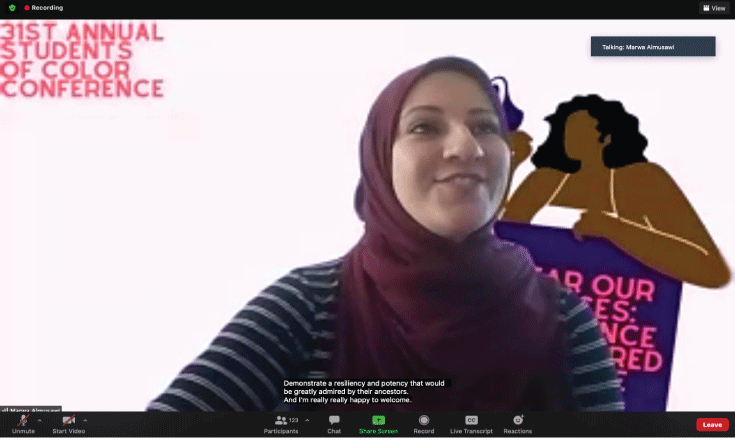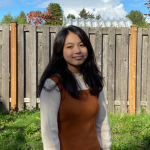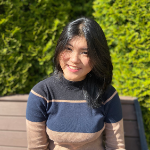On April 15 and April 16, more than a hundred people participated in this year’s 31st annual Student of Color Conference (SOCC) which was held virtually on Zoom.
Through identity development, awareness of others, skill development, social activism, and personal development, the conference strives to guide students on a focused path to realizing the comprehensive value of racial difference in society.
On April 15th, Roxana Pardo Garcia aka La Roxay, founder of La Roxay Productions, joined the Conference to host a workshop that guided participants through a series of reflections that identify the white supremacist roots in our workspace and offered solutions to challenge these notions and carve out spaces for authenticity.
La Roxay emphasized that her workshop is centered around a healing justice framework and not about assimilation, perpetuating harms or replicating systems and cultures of oppression. Firstly, La Roxay introduced us to language as it relates to power, privilege, and oppression. She provided the audience with an interesting infographic that outlined the effect colonization has on our society.
La Roxay went over some of the terms that were vital to the workshop before listing out examples on the culture of white supremacy that we experience daily. These examples include perfectionism, power hoarding, fear of open conflict, objectivity, individualism, and comfort with predominantly white leadership.
At the end of the workshop, reflections were made. La Roxay emphasized how important it is to develop a strong sense of culture and identity and to know who you are historically and presently. “Let your energy introduce you,” she said. After closing statements, La Roxay bid everyone a good rest of the day and wrapped up the workshop.
On Friday April 16th, a special guest, Isabel Wilkerson, winner of the Pulitzer Prize in journalism, author of the critically acclaimed and New York Times bestsellers The Warmth of Other Suns, and Caste: The Origins of Our Discontents, gave a discussion and Q&A session focused on social activism and social justice for people of color, especially Black and Brown people.
The discussion opened with Vincente R. Lopez with the Land & Free Acknowledgement and a moment of silence for those who have paved the way for us.
Wilkerson started discussing how Black and Brown people have suffered during the pandemic, notably by how the roles they have been assigned in the community make them more susceptible to contracting the virus, like being bus drivers and grocery stockers. They are the ones assigned in the economy to be sickened easily, and they are less likely to receive treatment. Wilkerson also highlighted that studies have found a fallacy in the medical field that Black and Brown patients can bear and sustain pain better, thus they are often not given adequate pain medication.
She quoted a statement from Martin Luther King Jr. that clarified himself as “an ‘untouchable,’ and every Negro in the United States of America is an untouchable.” She talked about how the colonizers used the metric of “race” to determine who could be ‘bought’ or ‘sold’ or who could ‘be property’ or who could ‘buy property.’
The discussion continued with Wilkerson mentioning George Floyd. “We saw a man killed. It shouldn’t be anyone who was killed,” she stated. She also spoke about what happened earlier in January: a mob broke into the citadel of democracy, attacking police officers, looting the belongings of the lawmakers, and so on. However, these people walked freely through the Capitol untouched, with their race giving them the benefit of the doubt. Later, a video was published through the media showing the aftermath of the attack inside the Capitol: janitors cleaning up after the rampage. They were all Black. The video also included a white police officer standing over them with no face mask. “Those people are still being moulded into serving and cleaning up for the dominant race. We saw a Confederate Flag in the U.S. Capitol. This is the thing we have to explain to the succeeding generation. We are witnessing the consequence of the racial issue in this country,” Wilkerson expressed.
After half an hour of discussion, the conference moved to the Q&A session.
One of the questions raised for Wilkerson was “How might parents and educators help children turn feelings of helplessness, in terms of racial disparity, into power?” She highlighted a video on social media about how families of color must give “the talk” to their children in order to protect them. Wilkerson led with another example of an 8-year-old girl who had to memorize a script to protect herself from the law enforcement authorities who were supposedly paid to protect her. A suggestion to the given question is to see what has sustained families of color over the years and see what the ancestors have done to survive racial ordeals in the past. In fact, because they survived we are here, and we can and must do the same as them. Wilkerson emphasized that we humankind must take good care of ourselves and bring love and joy into life to balance out the traumas. We are all eye-witnesses to what is happening to society. Furthermore, Wilkerson wanted us to allow children to be themselves sometimes, since society has stripped away too much from them.
Another question was asked: “What do you believe is necessary for people of color to have authentic relationships with white people?” Wilkerson believed it was a benefit for others to get to know people who have been marginalized by society. She made a point of authenticity, which means you can be your true self. Since each race has accompanying stereotypes set by society, it is hard not to perform to the expectation of the world. It is a form of restriction, not leaving room for people to show who they truly are. Having such issues in place, we cannot get to know the true authenticity of each other. In the end, being free from stereotyping enables each of us to recognize and have authentic relationships.
Wilkerson was asked one last question: “How do you reconcile love and race and social justice with the beneficiaries of racism? There are many people who claim to not be racist, but in the workplace, they hardly ever hire racially different workers, or they contribute to a hostile work environment.” She explained that human beings exist on a continuum. We have a long-standing hierarchy of racism embedded into our society and it still plays in our current environments. You have to be constantly vigilant, because this is a constant problem. It is sad to say that there is no solid “cure” for racism, not even our elected officials can erase it entirely. It is a life-long challenge and each of us, as individuals, must fight to abolish it.













Be First to Comment